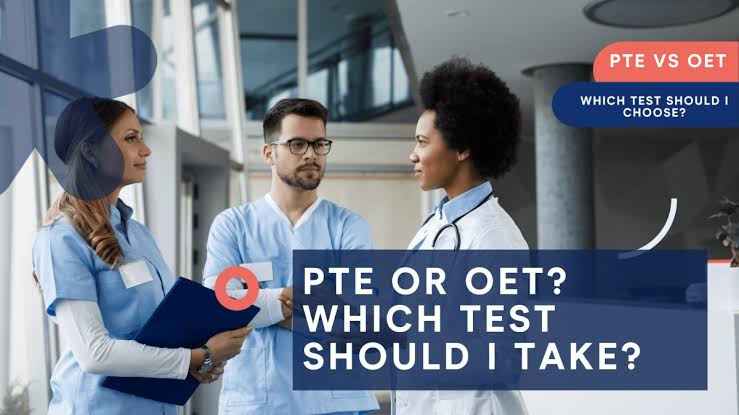How OET and PTE Online Compare in Terms of Difficulty?
Are you a working professional looking for career prospects in Australia? Besides your application, CV, and other important documents, acing an English proficiency test is a must. However, if you are a healthcare professional or an international student, choosing between Occupational English Test (OET) and the Pearson Test of English (PTE) can be challenging.
Both these tests prove English language skills but they are designed for different career needs. Moreover, these tests have difficulty levels which can be difficult to understand to the first time test takers. In this blog, we will compare OET and PTE Online in terms of difficulty, breaking down their components to make your preparation strategy better.
Understanding the Basics: OET vs. PTE Online
Before figuring out the difficulty levels of each of these exams, let’s understand what the OET and PTE Online is and who should consider these tests.
OET online exam is the English language test for healthcare professionals who are looking to work in Australia or move abroad. If you are a nurse, doctor, dentist, or a pharmacist, the OET online exam is designed specifically for you. The test contains a set of questions which are within the medical context, meaning it judges your English proficiency to read, understand, listen, and converse fluently in a clinical environment.
On the other hand, the PTE Online is a general English proficiency test for anyone who is looking to work or study within or outside Australia. Many accredited and popular universities, colleges, and governments worldwide accept the PTE online exam as an eligibility requirement. The test checks your ability to understand and use English in academic and everyday conversations.
Comparing the Structure and Content
Now that you understand the basics of both these exams, you should also learn the structure and content of OET and PTE Online to understand their difficulty level. Let’s now compare each of the Listening, Reading, Writing, and Speaking skills in OET and PTE exams to learn their difficulty level.
- Listening
OET Listening:
In the OET listening section, you will listen to consultations, patient interactions, and lectures, and then extract relevant information. This will test your ability to understand and interpret medical conversations.
PTE Listening:
In the PTE Listening section, you will summarise spoken texts, fill in the blanks, and pick one right answer from multiple-choice questions. The variety of topics and accents make the test equally challenging.
Difficulty Comparison:
The OET Listening section is easier to prepare as it is within the medical terms and contexts. The PTE listening section, however, can be more challenging as it tests your ability to understand your English listening skills on various topics.
- Reading
OET Reading:
In the Part A of the reading section, you are scanning the text to find the relevant medical information. However, in parts B and C, you will be reading longer texts, including policies, procedures, and research articles specifically in the healthcare industry. The medical terms and phrases used in these documents can be harder to understand.
PTE Reading:
In the PTE online reading section, you will have to read and choose the right answers for multiple-choice questions, reorder paragraphs, and fill in the blanks. The topics are mostly academic and general topics, but the vocabulary can be difficult for beginners.
Difficulty Comparison:
As only medical professionals choose the OET exam, reading medical terms and paras should not be difficult. However, PTE reading tasks are not specific to any industry. You will require strong general reading comprehension skills and the ability to understand different types of content quickly.
- Writing
OET Writing:
In the OET Writing section, a case note will appear on the screen. On the basis of the information given, you will write a referral, discharge, or transfer letter. The section judges your ability to structure the letter, use correct medical terms, and write the information clearly under a time limit.
PTE Writing:
This PTE online writing section will test if you can summarise the written paragraph and write an essay on different topics. Ultimately, it checks if you can express ideas, use the right vocabulary and grammar, and write at speed.
Difficulty Comparison:
The OET Writing section might be less challenging for those with experience in healthcare. However, the writing requires formal tone and good understanding which can be tricky. PTE Writing requires strong academic writing skills. If you are only focusing on specialised content, this section can get a little harder.
- Speaking
OET Speaking:
The OET Speaking section will ask you to explain a diagnosis to a patient, provide instructions, or respond to a patient’s concerns.
PTE Speaking:
In the PTE Speaking you will be reading aloud, repeating sentences, describing images, and answering short questions. As these tasks are not industry-specific, it is crucial to focus on overall fluency and pronunciation skills.
Difficulty Comparison:
If you have experience interacting with patients and discussing medical issues, then that can be beneficial to ace the OET speaking section. However, speaking clearly and with empathy is something that still you have to learn. In the PTE Online Speaking, English proficiency can be challenging if you are unable to come up with the right words at the right time.
Scoring Systems: Understanding the Metrics
Now, let’s get familiar with the scoring system in both OET and PTE exams.
OET Scoring:
OET has a grading system from A to E. You will receive scores in each sub-test (Listening, Reading, Writing, and Speaking) based on your performance in specific healthcare-related tasks.
PTE Scoring:
PTE Online has a scoring that ranges on a scale of 10 to 90. The test uses an automated AI scoring system to evaluate your responses.
Difficulty Comparison:
OET’s scoring system might be easier to understand for those who perform well in healthcare-specific tasks. However, professional communication requires accuracy which can be demanding. PTE has automated scoring that requires a strong command of general English and ability to perform consistently well.
Quick Comparison: Which is More Difficult?
The OET test might be less challenging for healthcare professionals as it has industry-specific content and is relevant to everyday clinical tasks. However, you must understand the medical terms and should possess the ability to communicate effectively in a healthcare setting.
On the other hand, PTE Online offers a more broader and diverse content. Its automated scoring system demands a strong command of general English, which can be challenging for those who prefer more specialised tasks.
Final Words
We hope you found this blog useful. Determining whether OET or PTE Online is more difficult depends on your background, career goals, and language proficiency.
Ultimately, choosing between OET and PTE English language tests should be based on your needs and strengths. If you are a healthcare professional, the OET exam might be more appropriate. Also, if you are a non-healthcare working professional or academic aspirant, then the PTE online exam is the best choice. Both tests can be difficult to attempt without a proper strategy and resources.
This blog should be a comprehensive comparison to guide you through choosing a test that best prepares you for success. And If you are choosing a nearby coaching centre, then EnglishWise is the best learning centre for preparing both these exams.






